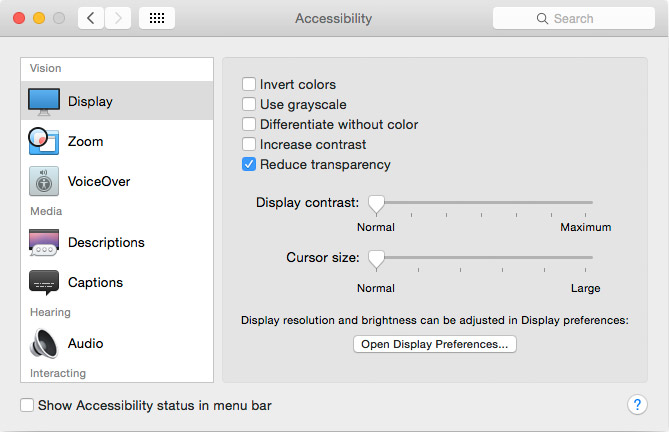
This feature is a double-edged sword: while increased cursor size is invaluable for many low vision users, the larger size obscures text and graphical elements underneath it.ĭisplay > Open Display Preferences: This button takes you directly to the Displays Preferences, which provides options for Resolution, Brightness, and Color. (Note that sliding Display Contrast to Maximum renders the screen so bright that it may be painful for photophobic users.)ĭisplay > Cursor Size: This slider increases the size of the pointer arrow, the cursor, and the spinning beach ball cursor. You may have to experiment with the Increase Contrast checkbox and this slider in order to adjust both settings to your preferred values. This so-called “transparency” is actually translucency - and there’s no need for it in the context of menus or sidebars if it makes the interface harder to see.ĭisplay > Display Contrast: This slider increases the contrast of the screen itself. At first glance, this may look cool, but many users - and not just those with visual impairments - find that the menus and sidebars appear blurry and that the fonts of the menu text are too thin. Third, it reverts the new flattened appearance of Yosemite’s graphical design to a more traditional look.ĭisplay > Reduce Transparency: In Yosemite, Apple introduced what it calls “transparency” to menus and sidebars in the Finder and iTunes, so that users can (sort of) see the desktop through the menus and the sidebars.

Second, it enables the Reduce Transparency checkbox discussed next. This is helpful for many types of visual impairments, including color-blindness. First, it increases the contrast of elements on the screen (such as buttons, button borders, and boxes) without changing the contrast of the screen itself. According to the Apple Support page, checking this box makes Yosemite “use shapes, in addition to or instead of color, to convey status or information.” So far, the only thing that Differentiate Without Color changes is transforming the Away status indicators in Messages from circles to squares.ĭisplay > Increase Contrast: Activating this achieves a few results. It often makes charts and diagrams much more difficult to view.ĭisplay > Use Grayscale: Checking this box drains the screen of color, which is useful for colorblind users who have trouble discerning the subtle differences between hues with the same saturation or color values.ĭisplay > Differentiate Without Color: Here’s another feature for colorblind users, although it seems to be a work in progress. Bear in mind, however, that checking this box inverts all colors, including those in graphics, making them look like photo negatives. Display > Invert Colors: Enabling this inverts all the colors on screen, which can ease the reading of text for some users who prefer light text on a dark background.I’ll begin with what’s already at hand, built in to your Mac.Īccessibility Display Preferences - If you haven’t yet experimented with the Accessibility > Display pane of System Preferences in OS X 10.10 Yosemite, note that each of the following is adjustable for visual needs: Now I will detail the visual accessibility features, guides, and third-party apps that are available. The next step is to seek and implement solutions (or to invent them if they don’t yet exist). Identifying the problem is the first step in fixing it. Part three (see “ Computing for the Visually Impaired, Part 3,” 26 January 2015) comprised a long list of design flaws that render even basic computer tasks unnecessarily difficult for In part two (see “ Computing for the Visually Impaired, Part 2,” 19 January 2015), I covered the myriad defects that can affect eyes and vision in general.
HOW TO REFORMAT MAC AIR YOSEMITE SERIES
First, in part one of this series (see “ Computing for the Visually Impaired, Part 1,” 9 January 2015), I regaled you with the horror story of my eye troubles and resultant temporary vision problems. I know, because I’ve spent a lot of time complaining.

#1606: Apple's self-sabotaging App Store policies, edit Slack messages easily, WWDC 2022 dates.#1607: TidBITS 32nd anniversary, moving from 1Password to KeePass, pasting plain text, Mail fixes anchor links, RIP Eolake.
HOW TO REFORMAT MAC AIR YOSEMITE HOW TO
#1608: How to test Internet responsiveness, Wordle takeoffs, understand cryptocurrency.


 0 kommentar(er)
0 kommentar(er)
